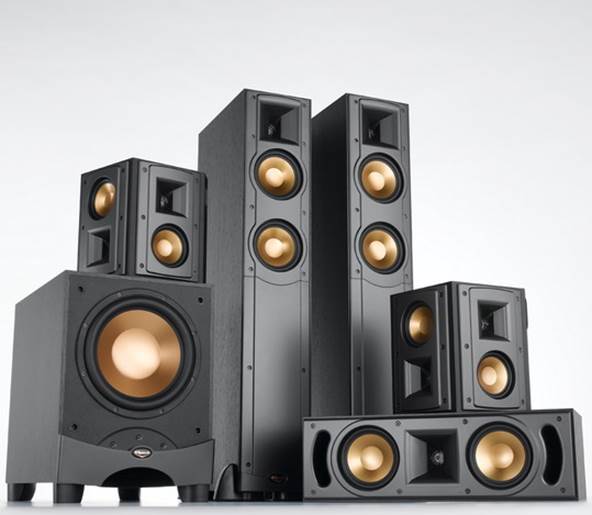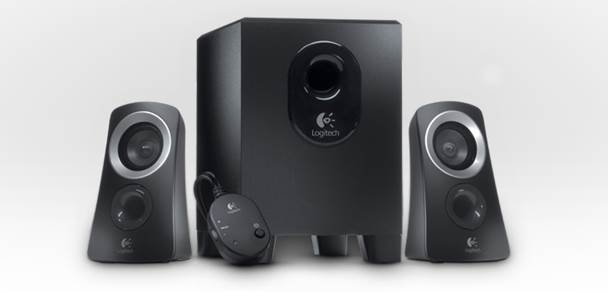Speaker terminology sounds a bit odd, but
it’s really quite simple once you understand the terms. Broadly speaking, all
you need to know is that subwoofers enhance sounds in a low frequency range
(bass), tweeters enhance sounds in a high frequency range (treble), and if
anyone says “drivers” they don’t mean software controllers, but the cones
inside speakers which produce sound by vibrating, or 'driving' the air around
them.

Although
it has the appearance of a decimal version number, it’s actually referring to
the configuration of the hardware. The first digit gives the number of
stand-alone speakers (or 'satellites'), while the second tells you how many
subwoofers there are.
Although speakers come in many different
setups, you can easily tell what type you’re buying by looking at the number
it’s been assigned. Although it has the appearance of a decimal version number,
it’s actually referring to the configuration of the hardware. The first digit
gives the number of stand-alone speakers (or 'satellites'), while the second
tells you how many subwoofers there are.
So, for example, a numbering of 2.0 tells
you that you’re buying a standard stereo system with no subwoofer, while a
numbering of 5.1 means that you get a 5-speaker surround system with one
subwoofer. It’s important to remember that higher numbers aren’t inherently
better - although they do allow you the potential to access greater features,
it’s possible to that a 2.1 speaker system will sound better than 5.1 speakers,
if you spend more on them. The important thing is to choose the right setup for
the job you want them to do. With that in mind, just so you know what the right
setup is, we’ll tell you.
If anyone says 'drivers' they don’t mean
software controllers, but the cones inside speakers
2.0 speaker systems are simple, low-power
and sometimes even portable. They don’t have to be cheap, but they often are,
since most enthusiasts consider a powered, separate subwoofer essential for bringing
out bass. By contrast, the best you can expect on most 2.0 systems is a
built-in passive woofer that might shake your desk, but won’t rattle the
windows. 2.0 setups are suitable for light, general use, low-budget systems, or
as an upgrade from integrated speakers.
As we’ve already explained, 2.1 setups
include a separate subwoofer to enhance the bass, making them perfect all-round
solutions for PCs that play a lot of music, do a little gaming and get used for
watching films and television. Anyone who’s half-serious about the way their PC
sounds should be looking for this kind of setup at least, but they do cost a
little more. Beware cheap examples, though, because a bad subwoofer isn’t worth
owning.
Once you go beyond 2.1, you enter 5.1 and
7.1 surround sound territory. These setups are strictly for enthusiasts
(whether they’re an enthusiast of music, gaming or movie-viewing - though it's
usually the latter two of the trio). These systems will see significant
benefits from being paired with a proper sound card or home theatre decoder,
and since you have to pay a premium in both cost and space requirements, make
sure you’ve got enough of an appreciation for the audio to make them worth
having around!
In terms of technical statistics, don’t pay
too much attention to things like frequency ranges and other important-sounding
values. These are always doctored and sometimes pass into being complete
gibberish. At the very least, you can’t trust two different manufacturers to
have used the same tests to determine the hardware’s capabilities, so they’re
useless as a comparison point.
Is Now The Right Time To Buy?
Speakers never go out of fashion. Nor do
they ever really come into fashion. This makes them exceedingly dull when it
comes to analyzing the market. To put it bluntly, when you need some speakers,
buy some speakers, the chances of you missing out on some amazing technical
innovation are as close to zero at a block of ice. This is one area of
computing where pretty much all of the advances have been made.
If you’re really desperate to find the
inside track, though, the best we can offer is to say that the price of
wireless speakers hasn’t quite bottomed out. Advances in wireless technology
will doubtlessly improve them in the future, so do investigate properly if
you’re thinking of buying a pair, and maybe consider getting their much cheaper
(if technically unimpressive) wired cousins at least once more before you try
and go wireless for good.
What Are The Technical Constraints?
The technical constraints on speaker
systems broadly boil down to one question: what’s plugging in where?
If you’ve got a good pair of speakers, you
can expect to have a variety of inputs capable of accepting various audio
signals using differing connections. A standard 3.5 mm jack might be enough for
most people, but if you’re aiming for a professional-quality setup that you can
use with a TV, separate amplifier/subwoofer, or high-end sound card, you’ll
want greater capabilities, such as RCA or even optical input. If you spend a lot
of money on your speakers, make sure they’ve got as many inputs as possible so
that you can keep your options open with regard to using them in the future.

If
you spend a lot of money on your speakers, make sure they’ve got as many inputs
as possible so that you can keep your options open with regard to using them in
the future.
You should also pay attention to whether
speakers are powered (active) or unpowered (passive). Active speakers are
common, they contain a built-in amplifier which improves the quality and volume
of their output. Passive speakers, on the other hand, are either so cheap that
they leave the amplifier out (meaning that they’re also quiet, tinny, and
flimsy) or so expensive that they assume you’ve got your own, separate
amplifier. You should be able to tell pretty easily which you’re looking at
based on price alone. Unless you know better, go for the active option.
One final technical element to consider is
how and where your speakers will actually be set up. It doesn’t matter how much
money you spend on speakers – if you don’t put them in the right place, you’ll
end up with sub-optimal sound.
There’s no easy way to explain how speaker
systems should be set up, but in simple terms, your aim is to have the sound
waves converging right in your ears without crossing or interfering with one
another. You should also try and keep them a reasonable distance from walls and
placed on vibration-free surfaces to minimize environmental interference. If
that’s not detailed enough for you, it’s time to hit up an online AV forum and
get the audiophile’s opinion!
What’s The Alternative?
Stand-alone speakers aren’t what you’d call
an essential component for any PC. Sure, they can make a good soundcard sound
great, but if you’re short on desk space, plug sockets or USB ports, there are
alternatives that might suit you better.

if
you’re short on desk space, plug sockets or USB ports, there are alternatives
that might suit you better.
For example, many monitors come with
integrated speakers that do the job. Admittedly, they don’t often do it very
well, but if you’re not interested in using them for listening to music or
watching TV and films, they’ll do it well enough. Buy a monitor with built-in
speakers and you’ll be able to save money and space on stand-alone speakers in
the future. Audiophiles need not apply, however; they'll drive you mad.
So what should you do if you do want good
quality sound? Well, you could skip the speakers and go straight for a decent
pair of headphones. There’s actually a lot to be said for headphones: they’re
portable and use less power than speakers, but can produce amazingly clear
sounds. They also block out the world around you, leading to a more immersive
experience that is especially good for games.
Doubly so, if they’re noise-cancelling!
However, a sophisticated pair of headphones are, let’s face it, vastly more
expensive than even a half-decent speaker system, but you can also get some
crazily good quality audio (and even surround features!) out of them for less
than the price of a home cinema system. All this, and they don’t even wake up
the neighbors.
No-one’s suggesting that headphones are
perfect replacements for speakers, but if you want faithful sound reproduction
at lower prices, it’s safe to say that they’re by far the best alternative.